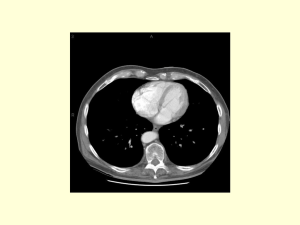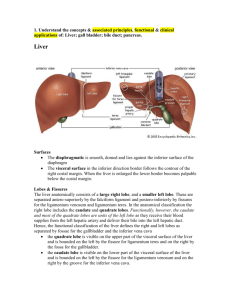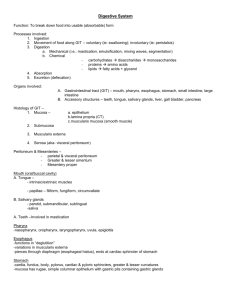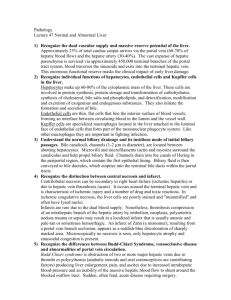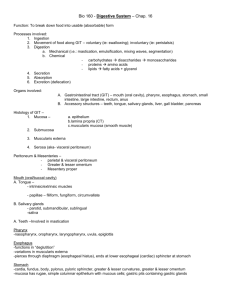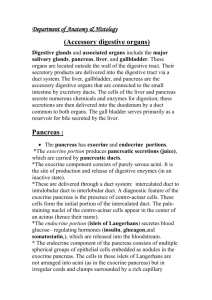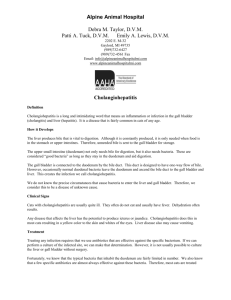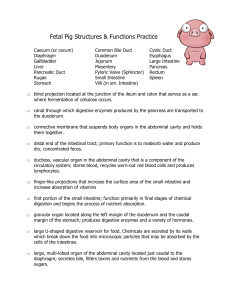Dissection 27
advertisement
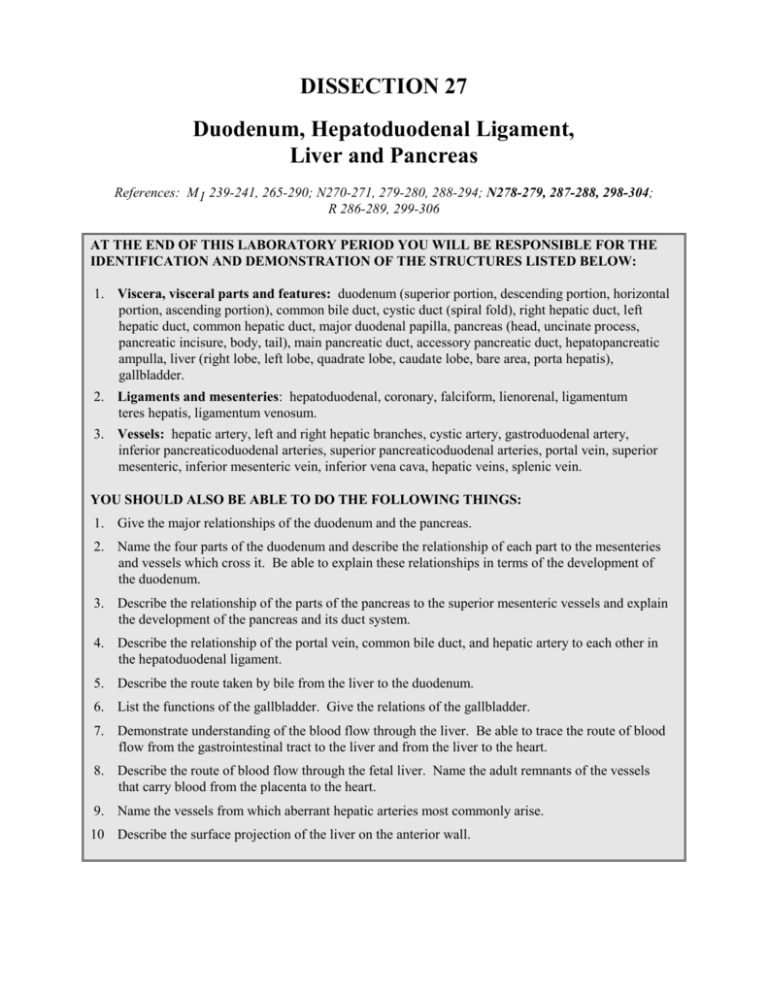
DISSECTION 27 Duodenum, Hepatoduodenal Ligament, Liver and Pancreas References: M1 239-241, 265-290; N270-271, 279-280, 288-294; N278-279, 287-288, 298-304; R 286-289, 299-306 AT THE END OF THIS LABORATORY PERIOD YOU WILL BE RESPONSIBLE FOR THE IDENTIFICATION AND DEMONSTRATION OF THE STRUCTURES LISTED BELOW: 1. Viscera, visceral parts and features: duodenum (superior portion, descending portion, horizontal portion, ascending portion), common bile duct, cystic duct (spiral fold), right hepatic duct, left hepatic duct, common hepatic duct, major duodenal papilla, pancreas (head, uncinate process, pancreatic incisure, body, tail), main pancreatic duct, accessory pancreatic duct, hepatopancreatic ampulla, liver (right lobe, left lobe, quadrate lobe, caudate lobe, bare area, porta hepatis), gallbladder. 2. Ligaments and mesenteries: hepatoduodenal, coronary, falciform, lienorenal, ligamentum teres hepatis, ligamentum venosum. 3. Vessels: hepatic artery, left and right hepatic branches, cystic artery, gastroduodenal artery, inferior pancreaticoduodenal arteries, superior pancreaticoduodenal arteries, portal vein, superior mesenteric, inferior mesenteric vein, inferior vena cava, hepatic veins, splenic vein. YOU SHOULD ALSO BE ABLE TO DO THE FOLLOWING THINGS: 1. Give the major relationships of the duodenum and the pancreas. 2. Name the four parts of the duodenum and describe the relationship of each part to the mesenteries and vessels which cross it. Be able to explain these relationships in terms of the development of the duodenum. 3. Describe the relationship of the parts of the pancreas to the superior mesenteric vessels and explain the development of the pancreas and its duct system. 4. Describe the relationship of the portal vein, common bile duct, and hepatic artery to each other in the hepatoduodenal ligament. 5. Describe the route taken by bile from the liver to the duodenum. 6. List the functions of the gallbladder. Give the relations of the gallbladder. 7. Demonstrate understanding of the blood flow through the liver. Be able to trace the route of blood flow from the gastrointestinal tract to the liver and from the liver to the heart. 8. Describe the route of blood flow through the fetal liver. Name the adult remnants of the vessels that carry blood from the placenta to the heart. 9. Name the vessels from which aberrant hepatic arteries most commonly arise. 10 Describe the surface projection of the liver on the anterior wall. Dissection 27, Duodenum, Liver, Pancreas Page 2 Duodenum Differentiate the four parts of the DUODENUM and study the relationships of each part (G2.33, 37; N270, 271; N278, 279). Note the relationship of the SUPERIOR PORTION OF THE DUODENUM to the gallbladder; the relationship of the DESCENDING PORTION to the transverse mesocolon, to the right kidney, and to the head of the pancreas; the relationship of the HORIZONTAL PORTION to the mesentery of the jejunum, superior mesenteric vessels, to the inferior vena cava, and to the aorta. In your cadaver, see if there is a clear distinction between the horizontal portion and the ASCENDING PORTION of the duodenum. Make an incision through the anterior wall of the right portion of the stomach and continue it through the pyloric sphincter into the superior portion of the duodenum. Compare the muscular wall in this region of the stomach and in the duodenum. Observe the thick muscular wall in the stomach, and the mucosal folds (or rugae) which line the interior of the stomach (G2.27; N267; N275). Hepatoduodenal Ligament To observe the COMMON BILE DUCT, the HEPATIC ARTERY, and the PORTAL VEIN in the HEPATODUODENAL LIGAMENT, the peritoneum enclosing these three structures should be dissected away (G2.55A; N265, 280; N273, 288). Note the relationship of these three structures. Make a vertical incision, through peritoneum only, lateral to the descending portion of the duodenum. Reflect the descending duodenum and the head of the pancreas to the left until you are able to see the common bile duct entering the head of the pancreas. Clean the common bile duct toward the liver and identify the CYSTIC DUCT and the COMMON HEPATIC DUCT, which unite to form the common bile duct (G2.54B; N285; N294). Identify the RIGHT and LEFT hepatic ducts which unite to form the COMMON HEPATIC DUCT. Follow the cystic duct to the GALLBLADDER. Open the gallbladder and extend the incision into the cystic duct and examine the SPIRAL FOLD in the cystic duct (G2.37B; N285; N294). Follow the hepatic artery to the liver and identify its RIGHT and LEFT HEPATIC BRANCHES. Look for the CYSTIC ARTERY, which is usually a branch of the right hepatic artery. Make an incision in the anterior wall of the descending duodenum and identify the MAJOR DUODENAL PAPILLA (G2.37B; N271, 287; N279, 295). It may be partially hidden by a hood-like fold of mucous membrane. Feel for the mural portion of the common bile duct in the duodenal wall above the major papilla. Using a needle and syringe, inject a small amount of colored fluid into the supraduodenal portion of the common bile duct while observing the major duodenal papilla (or the mucous membrane of the posteromedial duodenal wall if you have not yet located the papilla). In some cadavers, a minor duodenal papilla may be found. Pancreas The PANCREAS lies in a horizontal position in front of the inferior vena cava and the aorta. The HEAD of the pancreas fits into the curve of the duodenum (N288; N298). Clean the SUPERIOR MESENTERIC VESSELS where they pass anterior to the horizontal portion of the duodenum. Note on which side of the artery the vein lies. Identify the UNCINATE PROCESS of the pancreas which lies posterior to the superior mesenteric vessels. Consult your text for the embryonic origin of the uncinate process. The uncinate process is separated from the rest of the pancreas by the PANCREATIC INCISURE (or notch) through which the superior mesenteric vessels pass. The BODY of the pancreas lies to the left of the pancreatic incisure. The TAIL of the pancreas lies in the LIENORENAL LIGAMENT with the splenic vessels. Clean the SPLENIC VEIN and identify the termination of the INFERIOR MESENTERIC VEIN. See if the inferior mesenteric vein drains into the splenic vein, the superior mesenteric vein or directly into the portal vein in your cadaver. Clean the portal vein from its origin to the entrance of its right and left branches into the substance of the liver in the PORTA HEPATIS. Identify INFERIOR PANCREATICODUODENAL ARTERIES branching from the superior mesenteric Dissection 27, Duodenum, Liver, Pancreas and SUPERIOR PANCREATICODUODENAL ARTERIES from the GASTRODUODENAL (G2.34; N291-294; N301-304). Remove glandular tissue from the body of the pancreas until you can identify the MAIN PANCREATIC DUCT. Follow this duct toward the duodenum, and if possible, identify the ACCESSORY PANCREATIC DUCT. Demonstrate the union of the main pancreatic duct and common bile duct to form the HEPATOPANCREATIC AMPULLA (ampulla of Vater) (G2.37B, 37C, 38; N287, 288; N295, 298) Liver The remaining dissection is to be done only at the odd numbered tables at this time. The liver should be left in the cadavers at the even numbered tables. Identify the CORONARY LIGAMENT and the FALCIFORM LIGAMENT (G2.19, 49; N267, 279; Page 3 to the body wall as possible, and if necessary, strip peritoneum away from the diaphragm rather than allowing it to tear from the liver. The object is to remove the liver with as many of its peritoneal coverings and ligaments as possible. Cut through the hepatogastric ligament near its attachment to the stomach. Then identify the INFERIOR VENA CAVA and cut it just above the right renal vein. Cut through the root structures of the liver (portal vein, hepatic artery, common bile duct) about half way between the duodenum and the liver. Cut across the remaining attachments of the liver to the diaphragm. Make a careful study of the liver identifying its peritoneal attachments, its BARE AREA, CAUDATE, QUADRATE, RIGHT, and LEFT LOBES, BILE DUCTS, ARTERIES, and VEINS, including the HEPATIC VEINS. Identify the LIGAMENTUM VENOSUM, and the LIGAMENTUM TERES HEPATIS (G2.49, 50; N279; N287). N275, 287). Cut them as close to their attachment ______________________________________________________________________________________ STUDY QUESTIONS 1. Trace bile from the right lobe of the liver to the gallbladder and then from the gallbladder to the duodenum naming all ducts traversed. 1. Right hepatic duct -- common hepatic duct -- cystic duct -- gallbladder -- cystic duct -- common bile duct -- hepatopancreatic ampulla -- duodenum. 2. What are the functions of the gallbladder? 2. Storage and concentration of bile. 3. What is the spiral fold? 3. The spiral fold is a mucosal fold located in the cystic duct. What is its function? 4. What are the names of the parts of the duodenum? It keeps the cystic duct constantly open so that bile can flow unimpeded in either direction. 4. First part -- superior part; second part --descending part; third part – horizontal part; fourth part -ascending part. Dissection 27, Duodenum, Liver, Pancreas Page 4 5. What is the principal posterior relation of the second part of the duodenum? 5. The hilum of the right kidney. 6. What structure crosses the middle of the second part of the duodenum anteriorly? 6. The transverse mesocolon. 7. What two important structures lie directly medial to (to the left of) the second part of the duodenum? 7. The head of the pancreas and the common bile duct. 8. What are the relations of the third part of the duodenum? 8 Cranially, the head and uncinate process of the pancreas. Ventrally, the superior mesenteric vessels in the mesentery of the jejunum and ileum. Dorsally, the aorta and inferior vena cava, the right ureter, and the inferior mesenteric artery. 9. When an accessory pancreatic duct is present, where does it end? 9. It ends in the minor duodenal papilla. How is it related to the common bile duct? It passes ventral to the common bile duct. 10. What is the duodenal cap or duodenal bulb? 10. The superior part of the duodenum. 11. Where is the spleen located? 11. High up in the left upper quadrant well under the costal margin. What would you ask a patient to do in order to give you a better chance of palpating an enlarged spleen? Ask him to take a deep breath. Is a normal spleen palpable? A normal spleen is not palpable. 12. What border of the liver does the physician attempt to palpate on physical examination? 12. The inferior margin. 13. Does the liver move with respiration? 13. Yes. 14. How far superiorly with respect to the anterior thoracic wall does the diaphragmatic surface of the liver extend? 14. To about the level of the fifth rib on the right side and the fifth intercostal space on the left side. Dissection 27, Duodenum, Liver, Pancreas Page 5 15. What is the porta hepatis? 15. A transverse fissure on the visceral surface of the liver between the quadrate and caudate lobes. 16. What structures enter and leave the liver at the porta hepatis? 16. The right and left hepatic arteries, the right and left branches of the portal vein, the right and left hepatic ducts. 17. How does blood get out of the liver? 17. Through the hepatic veins which drain into the inferior vena cava. 18. In the fetus, what is the exact route of blood flow from the left umbilical vein to the inferior vena cava? 18. Left umbilical vein -- ductus venosus -- inferior vena cava. 19. What ligaments remain in the adult as derivatives of these vessels? 19. Ligamentum teres hepatis and the ligamentum venosum. 20. What is the most common source of an aberrant left hepatic artery? 20. The left gastric artery. Of an aberrant right hepatic artery? 21. The portal vein is formed by the union of which vessels? The superior mesenteric artery. 21. The superior mesenteric vein and the splenic vein. Where does this union occur? Dorsal to the pancreas. 22. Where does the portal vein lie with respect to the other structures in the hepatoduodenal ligament? 22. The portal vein lies dorsal to the hepatic artery and to the left of the common bile duct. 23. Label as indicated: 23. a. inferior vena cava b. right lobe of liver c. gallbladder d. quadrate lobe e. fissure for the ligamentum teres f. left lobe g. porta hepatis h. fissure for the ligamentum venosum i. caudate lobe Dissection 27, Duodenum, Liver, Pancreas 24. Label as indicated: Page 6 24. a. hepatopancreatic ampulla b. common bile duct c. cystic duct d. gallbladder e. right hepatic artery f. left hepatic duct g. left hepatic artery h. left branch of portal vein i. common hepatic duct j. left gastric artery k. splenic artery l. gastroduodenal artery m. splenic vein n inferior mesenteric vein o. superior mesenteric vein 25. In what part of the duodenum are peptic ulcers usually located? Perforation of the duodenal wall by such an ulcer would allow leakage of duodenal contents into what space, if the ulcer were on the anterior wall? Posterior wall? 26. What are accessory hepatic ducts? What is their significance? 27. List four sites where portal systemic anastomoses occur in patients with portal hypertension. Which of these is the most important clinically? LJ:bh revised 06/8/09
